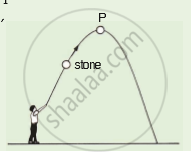Advertisements
Advertisements
Question
A ball of mass 0.5 kg slows down from a speed of 5 m/s so that of 3 m/s. Calculate the change in kinetic energy of the ball. State your answer giving proper units.
Solution
Mass of the ball, (m) = 0.5 kg
Initial velocity, (v1) = 5 m/s
Final velocity, (v2) = 3 m/s
So, initial kinetic energy can be calculated as,
`K.E = 1/2 mv^2`
Therefore, initial kinetic energy,
`(K.E)_1 = 1/2 xx 0.5 xx 5^2` J
= 6.25 J
Similarly, final kinetic energy,
`(K.E)_2 = 1/2 xx 0.5 xx 3^2` J
= 2.25 J
So, Work done = Change in kinetic energy
Therefore work done,
Work done = (KE)2 – (KE)1
= (2.25 – 6.25) J
= – 4 J
A negative sign shows that the force applied is opposite to the direction of motion of the body.
APPEARS IN
RELATED QUESTIONS
Does the transfer of energy take place when you push a huge rock with all your might and fail to move it? Where is the energy you spend going?
A ball of mass 0.20 kg is thrown vertically upwards with an initial velocity of 20 m s-1. Calculate the maximum potential energy it gains as it goes up.
Is energy a vector quantity?
What kind of energy is possessed by the following?
A compressed spring ____________.
A stone is thrown upwards as shown in the diagram. When it reaches P, which of the following has the greatest value of the stone?
Name the device or machine which convert :
Light energy into electrical energy.
Name the device or machine which convert :
light energy into heat energy.
What kind of energy transformations take place at a coal-based thermal power station?
Write the energy transformations which take place in an electric bulb (or electric lamp).
How much electric energy in kWh is consumed by an electrical appliance of 1000 watts when it is switched on for 60 minutes?
